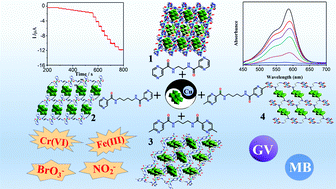The rational design of four multifunctional octamolybdate-based complexes for detecting different ions and removing organic dyes from aqueous solution†
Abstract
Four new octamolybdate-based metal–organic complexes derived from four different bis(pyrazine)–bis(amide) ligands, namely [Cu2(bpae)2(β-Mo8O26)]·6H2O (1), {H2Cu(bpab)(β-Mo8O26)(H2O)2}·2H2O (2), [Cu2(bmpap)(β-Mo8O26)(H2O)4]·3H2O (3), and {H2Cu(bmpab)(β-Mo8O26)(H2O)2}·2H2O (4) [bpae = N,N′-bis(2-pyrazinecarboxamide)-1,2-ethane, bpab = N,N′-bis(2-pyrazinecarboxamide)-1,4-butane, bmpap = N,N′-bis(5-methyl-2-pyrazinecarboxamide)-1,3-propane, and bmpab = N,N′-bis(5-methyl-2-pyrazinecarboxamide)-1,4-butane], were obtained through hydrothermal methods and characterized via single-crystal X-ray diffraction analysis, powder X-ray diffraction (PXRD), IR spectra, and thermal gravimetric (TG) analysis. Complex 1 possesses a 3,4,4-connected 3D topological structure, containing bidentate-coordinated [β-Mo8O26]4− (Mo8) anions and μ3-bridging bpae ligands. Complexes 2 and 4, derived from μ2-bridging bpab or bmpab ligands with diverse substituents, are isostructural and manifest a 2D supramolecular network constructed from 1D metal–organic chains, in which the Mo8 anions act as non-coordinating templates. Complex 3 displays a 2D network structure consisting of bidentate coordinated Mo8 anions and μ4-bridging bmpap ligands. It is worth noting that bmpap and bmpab are new ligands, and no relevant complexes have been reported. The effects of the lengths and substituents of the ligands on the architectures of 1–4 are discussed. All the complexes possess excellent amperometric sensing performance toward Cr(VI), Fe(III), BrO3−, and NO2− ions. Notably, the lowest detection limit of 1 toward Cr(VI) is 0.51 μM, which satisfies the standard for Cr(VI) in drinking water established by the World Health Organization (less than 0.05 ppm or 0.962 μM). In addition, the adsorption behaviors of 1–4 toward organic dyes were explored.

- This article is part of the themed collection: Coordination Networks


 Please wait while we load your content...
Please wait while we load your content...